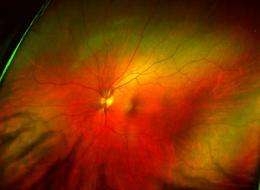December 22, 2015 report
Researchers successfully transplant human stem cells into monkey models with eye disease

(Medical Xpress)—A team of researchers affiliated with several institutions in Japan is reporting that they have successfully transplanted tissue derived from human embryonic stem cells into monkey models of the eye disease, retinitis pigmentosa. In their paper published in Proceedings of the National Academy of Sciences, the team describes their two-pronged approach and why they believe that their technique may one day help cure certain types of blindness in people.
Retinitis pigmentosa is a disease of the eye where the retina degenerates, resulting in loss of vision. Because of the complexity of the retina, diseases are much more difficult to treat than diseases that impact other eye parts—transplantation of a retina from a donor, for example, has been met with limited success. In this new effort, the researchers sought to learn more about whether it might be possible to grow a person a new retina using human embryonic stem cells (hESCs). Their research involved two major goals, the first was to find out if it was possible to grow structured mature photoreceptor layers from hESCs. The second was to see if such layers would integrate themselves naturally with the neurons that already exist in the back of the eye, a prerequisite to restoring sight.
The team reports that they were able to grow the photoreceptor layers using hESCs as envisioned and thus they proceeded on to achieving the second goal. Before they could do that though, they first had to develop two monkey models of retinal degeneration to mimic the impact of retinitis pigmentosa, which they then had to evaluate to assess their utility as test hosts. Once that test was passed, the retinal tissue was transplanted into the monkey models via grafting. The final stage was to monitor the tissue to see if synaptic contacts between the grafts and host occurred—it did, in several instances, confirming the viability of the procedure as a possible cure for retinitis pigmentosa in humans.
A lot more work will have to be done of course, before human trials can begin, first to make sure the grafted material is safe, which generally means, it will not develop cancerous tumors. After that, tests in primates will have to be done to determine if the procedure does indeed lead to restored sight.
More information: Transplantation of human embryonic stem cell-derived retinal tissue in two primate models of retinal degeneration, Proceedings of the National Academy of Sciences, www.pnas.org/cgi/doi/10.1073/pnas.1512590113
© 2015 Medical Xpress



















